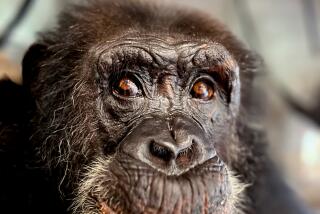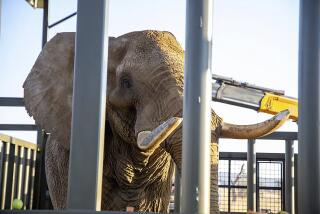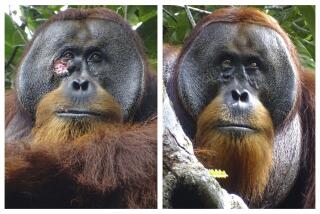Halfway House Aims to Train Orangutans to Be Wild
- Share via
SEMENGOK, Sarawak, Malaysia — Minah and BJ, now happily swinging on jungle vines, were just little orphans when they narrowly escaped a lifetime of captivity.
Bullet, who saw his mother gunned down, was raised by caring humans but suffered until the end of his days.
Loved too little or too much, these and other brainy, sensitive orangutans have paid a heavy price for encounters with their distant cousins, Homo sapiens.
The big, red-haired apes--orangutan translates as “man of the forest”--once ranged through Southeast Asia and southern China by the hundreds of thousands.
Destruction of their habitat and their capture by humans have dramatically shrunk their territory and numbers to an estimated 20,000-27,000 in Sumatra and on the island of Borneo.
But Homo sapiens are making some amends. Here and at four other halfway houses, “bicultural” apes are being weaned from hurtful human ways and put back where they belong: the rain forests.
“Students” at these centers have been rescued from poachers, wildlife dealers and families--both cruel and kind--who favor orangutans as pets because of their appealing looks and amusing antics.
Minah, a female, and BJ, a male, were saved by Malaysian officials while being sold to a dealer for about $4,000 each. They probably would have ended up behind bars in a zoo or a backyard.
Never having learned the ways of the wild, the pair had to be pushed up trees when first brought to the Semengok Orangutan Rehabilitation Center. They feared heights. Now, the rambunctious 3-year-olds eagerly grab the hands of trainer Hilary Kiding, who leads them to a jungle vine.
Minutes later they’re scampering upward, playing high up in tree branches and plucking leaves to make nests. Getting them back on the ground requires enticement with their favorite food, milk.
Because of worries they will get lost or hurt, or seek out human company outside the 1,600-acre reserve, both are still kept in a cage between training sessions. But within two years they’re expected to graduate to semi-wild status, roaming freely and choosing whether to come in from their haunts for two daily feedings.
These are magic moments at Semengok. The forest suddenly comes alive, its soaring canopy the stage for a graceful ballet of orangutans grasping lianas and branches to swing from tree to tree.
As visitors watch from a walkway through the jungle, Ritchie clambers down to a feeding platform, quickly securing four bananas in her mouth and a papaya between her toes. She shoots back up a trunk, fearful of Saduku, “the queen of Semengok.”
The 20-year-old dominant female seems to be meditating as she sits on the walkway, eyes blinking delicately, her reddish hair aglow with sunlight. She sips milk from a plastic container and takes long pauses between genteel nibbles on white bread.
She’s clearly at ease with humans, but Abdul Mutalib Tajudin, manager of the center, says that when there’s enough fruit in the forest, Saduku and the dozen other semi-wild animals currently in the reserve may not appear for several months.
“As much as we’ve grown to love them, we would like to see the orangutans leave us for the deep forest and mate,” Tajudin says. “They are our heritage. We hope they can multiply so that for future generations they won’t just end up as pictures in a book.”
Located 20 miles south of the Sarawak capital of Kuching, the center was established in 1975 by the state’s Forestry Department. Others are found in northern Sumatra, the Malaysian state of Sabah and Indonesia’s Kalimantan Province.
Along with rehabilitation, Semengok conducts research, captive breeding and wildlife education. It is also a popular but well-managed tourist site.
New orangutans are quarantined for one month and any ailments are treated. Then it’s “outbound school” for as many as four years of training in climbing, building nests, foraging for food and relating to others of their kind. Those who have lived with humans less than five years usually face few problems.
After the semi-wild stage, the final step is their release into large sanctuaries or remote tracts of forest, their contact with humans severed.
International protection for the endangered species, together with stiff penalties in Malaysia and Indonesia for illegally keeping or smuggling orangutans, appears to have stemmed some abuse.
The government has even cracked down in Taiwan, which in 1990 was estimated to have up to 2,000 captive orangutans. But Gary Shapiro, vice president of the Los Angeles-based Orangutan Foundation International, says smuggling continues to many points in the world where “anybody who has the money can still get an exotic pet.”
“We foresee a time when they will be truly safe only in national parks and game reserves,” he said in a telephone interview. “As long as trees are being felled and orangutans cornered into small stands of trees, they will be targets.”
Even getting distressed orangutans to the rehabilitation centers doesn’t guarantee a happy ending.
At Semengok, five apes have failed the course and are destined to remain caged exhibits for the rest of their lives. One has become overly aggressive, another smokes, several spit at visitors and Limot, confiscated after being raised with a human baby, sucks her thumb compulsively.
Then there’s Bullet, whose 242-pound body is preserved in a glass case. He has come to symbolize the plight of orangutans trapped between man’s world and their own.
Wounded by a hunter who killed his mother, he lived with a doctor’s family for four years. During his early stay at Semengok, the center lacked experience in rehabilitation. Bullet preferred the ground to trees and canned drinks to jungle pools.
With a keen interest in all things human, the gentle giant proved a star with visitors. But as he aged, Bullet grew unpredictable, frustrated, bored and occasionally aggressive. He would hug himself, gyrate madly and sometimes ransacked the quarters of employees.
Although he had to be caged, it was hoped that bringing him female companionship would help. When he and Saduku mated, the center cheered.
But Bullet died in 1994 of respiratory disease, leaving no offspring.
More to Read
Sign up for Essential California
The most important California stories and recommendations in your inbox every morning.
You may occasionally receive promotional content from the Los Angeles Times.










